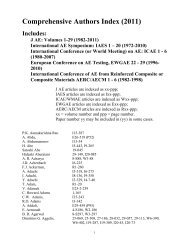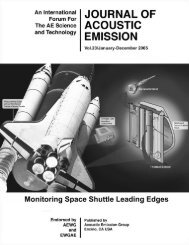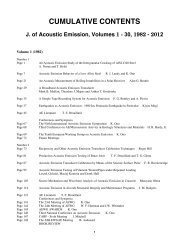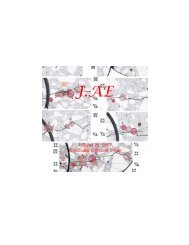Journal of AE, Volume 27, 2009 (ca. 35 MB) - AEWG
Journal of AE, Volume 27, 2009 (ca. 35 MB) - AEWG
Journal of AE, Volume 27, 2009 (ca. 35 MB) - AEWG
Create successful ePaper yourself
Turn your PDF publications into a flip-book with our unique Google optimized e-Paper software.
eference in that document to see if it pertained in any way to <strong>AE</strong>, which <strong>of</strong>ten led to some earlier<br />
publi<strong>ca</strong>tion on the subject. Those that looked promising, I would order a copy through my library. Those<br />
documents that were published in a language other than English, I would have translated into English.<br />
In 1990, I wrote an article entitled “Anecdotal History <strong>of</strong> Acoustic Emission from Wood” for publi<strong>ca</strong>tion<br />
in the <strong>Journal</strong> <strong>of</strong> Acoustic Emission. During my search for material, a number <strong>of</strong> references led me to<br />
what I believe was the first article ever written on a study <strong>of</strong> acoustic emission from wood by Pr<strong>of</strong>.<br />
Fuyuhiko Kishinouye. The article was published in 1934 in the Japanese seismologi<strong>ca</strong>l journal Jishin,<br />
with an English version published in 1937 in the Bulletin <strong>of</strong> the Earthquake Research Institute, Tokyo<br />
Imperial University. The reference was found in an article by Pr<strong>of</strong>. Kiyoo Mogi, who was at the<br />
Earthquake Research Institute, University <strong>of</strong> Tokyo. He stated, “The elastic shocks <strong>ca</strong>used by the fracture<br />
<strong>of</strong> solid materials were measured by F. Kishinouye for the purpose <strong>of</strong> investigation <strong>of</strong> earthquakes. He<br />
(Kishinouye) described the process <strong>of</strong> shock occurrences in wood specimens under flexural stress.”<br />
Pr<strong>of</strong>. Kishinouye had designed and performed a series <strong>of</strong> Gedanken, or thought experiments to amplify<br />
and record the many rapid, inaudible vibrations and cracking sounds produced by the fracture <strong>of</strong> wood, in<br />
order to study the fracture <strong>of</strong> the earth’s crust as the <strong>ca</strong>use <strong>of</strong> earthquakes, and solve the problem <strong>of</strong> timedistribution<br />
<strong>of</strong> earthquakes and, in particular, the Ito earthquake swarm that had occurred between<br />
February and June <strong>of</strong> 1930.<br />
The apparatus for the experiment consisted <strong>of</strong> a phonograph pickup using a steel needle inserted into the<br />
tension side <strong>of</strong> a wooden board to which a bending stress was applied to <strong>ca</strong>use fracture. Kishinouye<br />
stated: “When the board cracked, electric current was generated in the coil <strong>of</strong> the pick-up, the current<br />
being amplified with an amplifier, which formed a part <strong>of</strong> the Haeno radio-seismograph. The current was<br />
recorded with an oscillograph on cinematographic films.....As bending proceeded, cracking sounds were<br />
heard, while the oscillograms recorded many inaudible vibrations. The process <strong>of</strong> fracture varied with the<br />
velocity <strong>of</strong> bending, the kind <strong>of</strong> wood, the grain <strong>of</strong> the board, and the moisture content <strong>of</strong> the wooden<br />
board.....When the materials were the same and velocity <strong>of</strong> bending equal, the board broke with nearly<br />
equal deformation....When deformation proceeded slowly, oc<strong>ca</strong>sionally loud creaking sounds were heard<br />
owing to rupture <strong>of</strong> the grains, and low silent vibrations were found on the oscillogram.....It was found<br />
that the process <strong>of</strong> fracture is affected considerably by the condition <strong>of</strong> the experimented material and the<br />
particular way in which the force acts.”<br />
It is unfortunate that the pioneering instrumented <strong>AE</strong> experiment Pr<strong>of</strong>. Kishinouye conceived and<br />
performed was published in a journal in a field <strong>of</strong> technology outside the realm <strong>of</strong> <strong>AE</strong> scientists and<br />
engineers. However, the signifi<strong>ca</strong>nt accomplishment we do credit Pr<strong>of</strong>. Kishinouye with, is that the<br />
oscillograms he made were the first acoustic emission waveforms ever recorded.<br />
But, the birth <strong>of</strong> traditional acoustic emission would then have to wait until 1950 for the research work <strong>of</strong><br />
Joseph Kaiser in Germany, and publi<strong>ca</strong>tion <strong>of</strong> his doctoral dissertation. In 1954 a copy <strong>of</strong> Kaiser’s<br />
dissertation was translated for Brad Sch<strong>of</strong>ield in the U.S., who repeated and expanded on Kaiser’s<br />
experiments, which he published in a series <strong>of</strong> reports entitled “Acoustic Emission Under Applied<br />
Stress.” These publi<strong>ca</strong>tions precipitated research in a number <strong>of</strong> laboratories throughout the U.S. By the<br />
1960s, we find <strong>AE</strong> research being performed in many countries throughout the world.<br />
Thus we moved into what I <strong>ca</strong>ll the Golden Age <strong>of</strong> <strong>AE</strong> with the formation <strong>of</strong> the first three working<br />
groups: the Acoustic Emission Working Group in 1967, the Japanese Committee on Acoustic Emission in<br />
1969, and the European Working Group on Acoustic Emission in 1972.<br />
I will elaborate on just one <strong>of</strong> these working groups, the one here in Japan. It all started here in Kyoto in<br />
the summer <strong>of</strong> 1969, at the International Institute <strong>of</strong> Welding Conference where the term Acoustic<br />
Emission was mentioned in several <strong>of</strong> the papers and in some <strong>of</strong> the discussions. This piqued the interest<br />
<strong>of</strong> a number <strong>of</strong> the attendees. Later that year, in response to the interest generated from the IIW<br />
I-9








